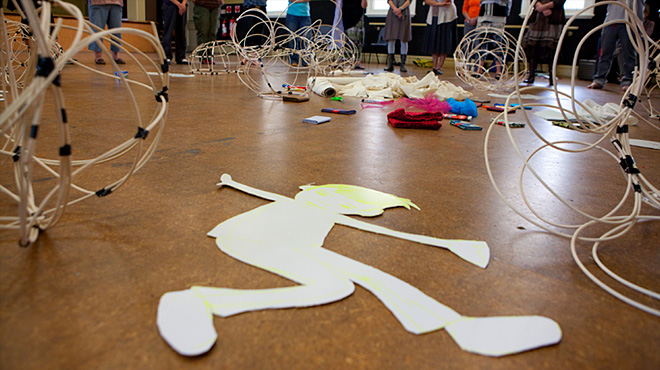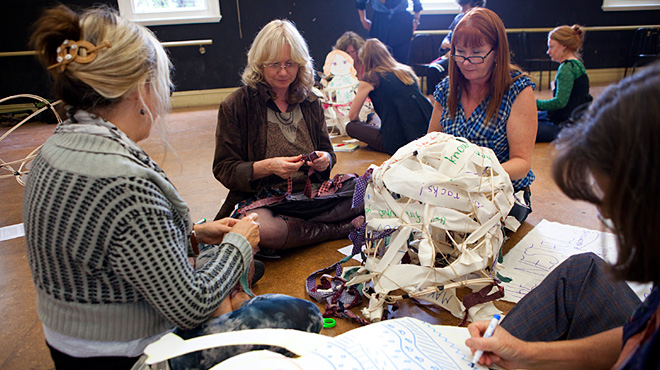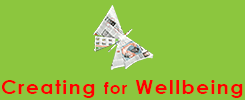Opening to Collaboration
Opening to Collaboration The Snakes & Ladders of Learning New Leaf, Old Leaf The Nest Le Salon
The Nest
This activity provides a creative process for professionals from arts, education and health to explore and represent the ways they might work together in promoting the wellbeing of young people. The Nest is a hands-on activity that involves interactive discussion and results in the construction of a sculptural, woven nest, tying together what each of these professions is able to contribute to the wellbeing of a young person.
Activity devised by Rosalie Hastwell for the Artists Training Program.

Description
The nest is a creative and fun process where participants from different professional backgrounds work together. They construct a sculptural, woven nest that ties together how their individual professional contributions can achieve their collective aims around the wellbeing of a child/young person.
Purpose
To use participant’s personal responses to images to generate a range of values related to the work about to be done.

Materials
- Canvas strips
- Textas
- Pieces of fabric (three different patterns or types) that appeal to everyone
- Scissors
- Glue
- Electrical tape
- Square piece of canvas
- Cane
- Tie wire

Instructions
- Make a nest framework: This is an open framework into which will be woven all the images and text that a group creates in this exercise. For the Artists Training Program (ATP) session pictured, an advance party made the nest framework for each group prior to the workshop day, in bird-nest and bowl-like shapes 0.8–1.0m across. They were constructed from cane held together with gaffer tape and wire.
- Make a child/young person template: This is an image of a child or young person made of paper, which is placed at the centre of the nest. These templates may be prepared for the participants before they commence the game. On the back of each template, participants will find some words to describe the child/young person on the back of the template. They need to give him/her a name, age and gender.
- Outline shared aims: In this process, participant teams imagine they are a team of artists/health professionals/teachers and they are going to be working together with this young person in a class. They want to tell the young person what it is that they (collectively) will be bringing to them as part of the Festival for Healthy Living (FHL) experience. It’s important here to use language that everyone – including the young person – understands. It’s important also to make sure that everyone agrees on what it is that they will be bringing individually and collectively that will contribute to the mental health of this young person. Each team member should agree that all of the chosen aims are relevant and important. Next, participants use a texta to write out each of these aims on a long narrow strip of canvas (There will be one aim per fabric strip). Participants next take the three different types of patterned fabric. The purpose of having the three contrasting fabrics is that each different pattern represents what an artist is able to bring, what a teacher is able to bring, and what a health professional is able to bring to the aims for the young person. Team members now attach piece(s) of patterned fabric to the end of each of these strips of canvas: one piece per “contribution” each professional brings to this particular aim. Before attaching the pieces of patterned fabric to the end(s) of the canvas strips, make sure that everyone agrees that it is realistic for that particular aim to be significantly supported/contributed to by the artist/health professional/teacher. The number of pieces of patterned fabrics attached at the ends of each strip of canvas will vary according to whether this is something that will be supported/contributed to by the teacher, the artist or the health professional. Teams could also vary the length or size of the pieces of patterned fabric to show who plays the largest part in making sure this aim is fulfilled.
- Weave fabric into the nest: Weave the strips of canvas – with their texts – into the “nest” (the structure made of cane) that will support the young person in their quest for wellbeing. When teams have finished making their nest, they place the child/young person in the centre of the nest.
- Record the process: The important final step is for each team to write up what they did (including the aims written on the strips of canvas) on the large square piece of canvas. This needs to be done in a way that is clear and engaging, as this will act as each group’s “message” to others who have not been part of the group.
- Proudly display and admire other nests! This may provide opportunities for creating a sense of ritual as the workshop participants travel around the space to view each group’s nest in turn, along with a presentation by each group of their documentation of the process and the learnings resulting from it.

Facilitator Notes
Aims and outcomes of The Nest exercise for the Artist Training Program
The Nest had strong aims and benefits in its position at the end of the two-day ATP workshop (called “Message, Meaning, Magic”). These included:
- Showing ATP organisers how participants had integrated the “message(s), meaning(s) and magic(s)” of the two-day program
- Allowing the state-wide Festival for Healthy Living (FHL) team to hear from different individuals and teams about how they interpreted the aims of the FHL and how they understood the various roles that teachers, artists and health professionals might play in this
- Acknowledging, valuing and celebrating the multiple perspectives of people working with the FHL and/or in other programs with overlapping aims
- Providing strong visual material for the training dvd and subsequent training materials
- Creating a sense of completion and providing the elements for a celebratory ritual as a way of closing the two days.
This activity provided a focus and a creative process for participants to collaboratively review and integrate key aspects of, in this case, the two preceding days of the Artist Training Program. These included:
- Understanding key messages about the links between mental health and the arts
- Understanding Festival for Healthy Living’s aims for students/participants
- Creating a space where “magic” can happen
- Exploring opportunities, challenges and solutions to working with professionals from other disciplines (arts, health, education).
For the FHL, “The Nest” provided representation, through creative form, of the Festival’s key aims for young peoples’ experiences and learnings. It is a way of exploring and representing the different (and variously overlapping) roles that can be played by artists, teachers and health professionals in delivering these experiences and learnings to students.
Acknowledgement
Photographs by Jorge de Araujo.
